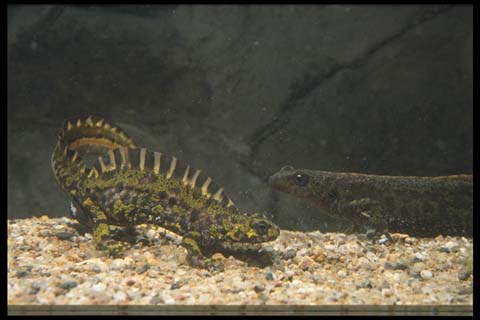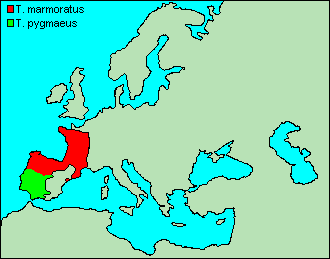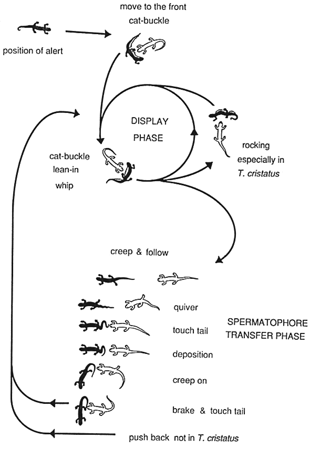

Male Triturus marmoratus (left) displaying to female (right). Photo by Max Sparreboom.


Mating behaviour: male shown in black, female in white. From Arntzen & Sparreboom (1989). This behaviour is common to these species, as well as the species in the T. cristatus group.
DESCRIPTION
The marbled newts are similar in size and build to the newts of the crested newt group, being around 14 cm. in total length, and rather heavily built. The upper surface is marked with black and green marblings, though the underneath is dull in colour. Breeding males develop a crest marked with black and white bands, while females and juveniles have an orange dorsal stripe. The nature of the dorsal marbling patterns can be used to distinguish the various species and subspecies (Arntzen, 2018).
The distribution of these species is confined to the Iberian peninsula, and the western part of France. In north-western France, there is a slight overlap in range between this species and T. cristatus, and hybrids may occur in this area.
T. pygmaeus was previously regarded as the subspecies T. marmoratus pygmaeus.
SPECIES
T. marmoratus
This species is distributed over the French part of this species'
range, and also over the northern half of Iberia. The belly
colouration of this subspecies is blackish with fine white dots.
The breeding male has a high crest, which is much lower at the
base of the tail, though it widens again on the tail itself.
T. pygmaeus
The Pygmy, or Southern, marbled newt is rather smaller, usually
reaching around 11 cm. in total length. This form exhibits
different belly colouration; the ventral surface is creamy yellow
with large black spots, and small white spots. In addition, the
crest of the breeding male is lower, and dips only slightly at
the base of the tail.
Two distinct subspecies have been recognised (Arntzen, 2023).
T. p. pygmaeus, the Southern or Cadiz Pygmy newt,
is found in the south-east of the range, has a dorsal colouration similar to T. marmoratus, and is small in size.
T. p. lusitanica, the Lusitanian Pygmy newt, is found further north, has more green in its dorsal colouration, and is larger,
though still notably smaller than T. marmoratus.
In the Donana National Park in southern Spain, a population of T. p. pygmaeus has been found that is even smaller than usual for this subspecies; adults averaged 7.7 cm. total length.
T. rudolfi
The Lisbon pygmy newt was recently described (Arntzen, 2024) as occupying a limited range in the Lisbon peninsula.
This species is intermediate in size between T. pygmaeus and T. marmoratus, with belly colouration similar to T. pygmaeus, and dorsal colouration more like T. marmoratus.
REFERENCES
Arntzen, J. W., 2018. Morphological and molecular characters to describe a marbled newt hybrid zone in the Iberian peninsula. Contributions to Zoology, 87(3): 167-185. [TEXT]
Arntzen, J. W., 2023. Morphological and genetic diversification of Old-World marbled newts, with the description of a new and 'not-at-all-cryptic' subspecies from the Iberian Peninsula (Triturus, Salamandridae). Contributions to Zoology 93(2): 127-152. [TEXT]
Arntzen, J. W., 2024. Morphological and genetic diversification of pygmy and marbled newts, with the description of a new species from the wider Lisbon Peninsula (Triturus, Salamandridae). Contributions to Zoology 93(2): 178-200. [TEXT]Arntzen, J. W. & Sparreboom, M., 1989. A phylogeny for the Old World newts, genus Triturus: biochemical and behavioural data. Journal of Zoology 219: 645-664. [ABSTRACT]
Diaz-Paniagua, C., Mateo, J. A., and Andreu, A. C., 1996. Age and size structure of populations of small marbled newts (Triturus marmoratus pygmaeus) from Donana National Park (SW Spain). A case of dwarfism among dwarfs. Journal of Zoology, 239(1): 83-92.
Garcia-Paris, M., Herrero, P., Martin, C., Dorda, J., Esteban, M., and Arano, B., 1993. Morphological characterization, cytogenetic analysis, and geographical distribution of the Pygmy Marbled Newt, Triturus marmoratus pygmaeus (Wolterstorff, 1905) (Caudata, Salamandridae). Bijdragen tot de Dierkunde, 63: 3-14
